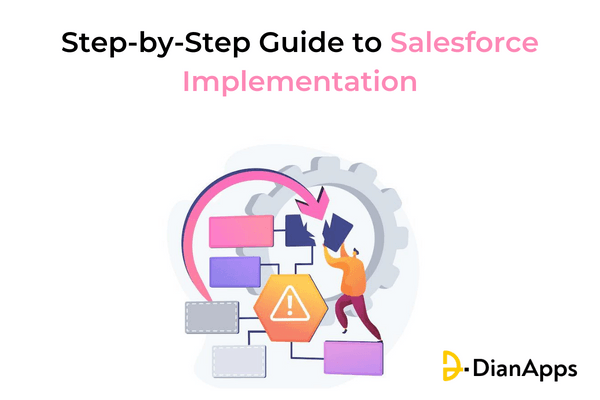Salesforce has become an empowering customer relationship management (CRM) tool for every business jack enabling them to connect and offer services to their customers via cloud-based software. Although, Salesforce Implementation services can be complicated for people who are completely new to the recurring concept.
Nevertheless, with the right CPQ implementation in place, businesses can seamlessly contemplate and address the demands of their customers in a timely and cost-effective way.
Based on a Statista report, Salesforce continues to dominate the CRM ecosystem with a margin of 23.9% market share. Ever since 1999, top businesses like Spotify, Toyota, Canon, and other 150,000 have increased their usage of CRM software services due to their extreme potential and successful optimization of business operations.
But why are so many companies trusting Salesforce in their technology revolution? To put it simply, the popularity is due to Salesforce implementation which guarantees an average of 37% hike in revenue and business productivity.
In case you are planning to implement Salesforce in your CRM software development yourself and looking to start from scratch then you have landed at the right place. Here in this blog, we are going to cover the ins and outs of CRM Salesforce Implementation. Also, how long does it take to implement Salesforce, how much does it cost, how to prepare for Salesforce implementation at its best, and lastly why is a Salesforce development consulting important for successful CRM rollout?
Read on to find the step-by-step Salesforce Implementation guide.
What is Salesforce Implementation?
Salesforce implementation can be defined as a process of rolling out its core product – CRM system development in regards to centralizing all the key business processes and conversions.
Salesforce Implementation unifies the three most vital yet common CRM product types, namely collaborative, operational, and analytical, making the platform stand on top in the CRM software development solution in the market.
Why Should You Implement Salesforce?
Salesforce combines a wide range of native products like Sales, Service, and Marketing Cloud catering to the demand of sales and marketing professionals. Apart from that, the platform is appreciated for its ample third-party tools such as Apex (the Salesforce app’s market) crafted to enhance the core operational power of a platform.
Due to Salesforce’s marketability, there is no lack of professionalism. The experts are always ready to help in customizing and implementing solutions as per your specific needs. So, if you are a complete newbie in the CRM landscape or not a tech-savvy proficient, our best suggestion would be to delegate these tasks to experienced Salesforce implementation consultants who reciprocate in-depth knowledge of the said platform.
Salesforce Services Market Outlook (2022-2029)
The global Salesforce development services market is set to top US$ 13 Bn in 2022 and is predicted to expand at a stupendous CAGR of 14.4% to reach a valuation of US$ 33.5 Bn by 2029.

Source: https://www.futuremarketinsights.com/reports/salesforce-services-market
Salesforce services currently account for a 2% share of the global IT services market. Market growth is primarily driven by the increasing adoption of salesforce services in the BFSI industry.
Step-by-Step Guide to Salesforce Implementation

Salesforce implementation can be a great investment for businesses across the globe. Therefore, the preparations mustn’t be taken lightly. Before you launch your project, start with the below-mentioned steps:
Step 1: Workshop
The very first step is to schedule a meeting with your stakeholders to discuss the main agenda and challenges and to have a complete picture of your business needs for salesforce implementation.
Although, it might seem that implementing Salesforce app development in your company is a one-and-done process but is not. It involves time and therefore must be bifurcated into smaller activities.
Above everything, you need to ensure all the possible risks and know what to target before taking any charges. Here are a few considerations that you can abide by at the Salesforce implementation ideation stage:
- Identify what kind of version of Salesforce suits the best for your company in terms of functionality and cost.
- Analyzing the potential dangers that may arise.
- Knowing the storage capacity of your hardware.
- Calculating the time invested while implementing the new system.
Step 2: Configuration & Customization
Salesforce customization and configuration are frequently confused and used synonymously. Changing Salesforce’s default settings is known as configuration, and adding functionality by extending the APEX code is known as customization. Don’t forget to consider end-user input in conjunction with the project.
Step 3: Integrations
Data must be centralized or at the very least move easily across systems. For instance, if your company is an online retailer, you should combine your CRM with order management programs. To call clients, ERP systems, etc., you might interface with calling or VOIP solutions. Gathering your clients’ demands, comprehending the processes, and integrating utilizing callouts, APEX Web services, or SOAP APIs are crucial steps in achieving this. Finally, be careful to run tests to verify that the system operates as planned.
Step 4: Data Migration
Every organization may already be utilizing a system, or at the absolute least an Excel sheet, to manage customer and account information before they begin using CRM. There would be no downtime involved in moving data from the traditional systems to the Salesforce platform. The internal administrator can also receive training on migration technologies like Dataloader along the route.
Step 5: Salesforce Training
Any Salesforce project’s success depends on user acceptance. The Salesforce custom app development platform’s navigation and use will be taught to the end users. The team may be terrified by the new system and the procedures that go along with it, but this training will reassure them and make sure they use the technology effectively. Overall, this has no negative effects on productivity. Additionally, Salesforce may be implemented gradually to prevent resistance from the workforce.
Step 6: Support
It’s crucial to remain accessible to the client in case any difficulties or troubleshooting is needed once Salesforce has gone live. Once a user begins to utilize the instrument to its greatest extent, there may be ‘n’ inquiries for them.
Know that we have covered all the vital steps that help companies in skyrocketing their salesforce implementation process, let’s move on to the best practices that you can make use of.
Best Salesforce Implementation Practices
- The executive team strongly affects user adoption. The other employees will use the new technology more effectively if the management team makes a push about its significance, worth, and effort.
- Every company will already have business processes in place. Implementing tools like CRM software development should be done in a way that makes the work of the sales staff simple.
- It’s essential to migrate outdated data and integrate it with technologies that have data. Poor data may cause users to reject the tool or mistakes in corporate procedures.
- Salesforce should be implemented so that it is simple for end users to use, including seamless data movement inside and across pages, ease of search and navigation, etc.
- Salesforce features should be developed such that they continue to function flawlessly as your company’s user base and level of complexity grow.
- Your daily activities should not rise but rather decrease as a result of Salesforce. This is where automation, approvals, triggers, etc., might be useful.
- The management team starts to depend on reports and dashboards. It must be exact, accurate, and significant.
Every team, including yours, should keep these suggestions in mind as they adopt Salesforce.
Common Mistakes in Salesforce Projects
Salesforce implementation is not simple. It could also become worse. The end users may not utilize the product at all after devoting so many hours to the project. To help you avoid them, we’ll go through a few typical errors in this section. You can stop them right now.
- Planning out the entire project is crucial. If a schedule or list of modifications isn’t established, you risk doing the same activity repeatedly or incorrectly.
- Failed Salesforce initiatives frequently have data problems. Business efficiency is frequently impacted by duplicate data and inaccurate or missing information.
- At the very beginning of the project, it is important to establish the roles of the stakeholders and the project manager. If this is not done as soon as possible, people start to play blame games without taking responsibility.
- Cloud software is frequently promoted as being user-friendly. However, occasionally the DIY procedures might go wrong and ruin the entire production. If necessary, seek professional guidance as soon as possible.
- Setting an improbable budget and milestone deadlines might result in project failure or Salesforce implementation that falls short of its full potential.
Salesforce Implementation Partners
During the implementation process, a common question may come across about whether to hire a salesforce development company. or should you do it yourself?
Budget restrictions may be a problem for many small and medium-sized organizations, thus they would rather handle setups themselves. On the other hand, having a partner or specialist handle the configuration and assistance is always a smart idea.
You must identify the objectives and operational procedures that work best for your organization. A partner might assist and offer advice on how to effectively integrate this procedure with the Salesforce technology. Their knowledge becomes useful at that point.
Consider hiring a Salesforce consulting partner if your company is expanding and has many departments that will utilize Salesforce.
Final Thoughts
Despite the ease of integrating Salesforce CRM, considerable planning and preparation are required for a successful launch. Due to the ongoing nature of Salesforce integration with your regular business operations, it is crucial to divide the process into smaller phases.
It is advisable to roll out Salesforce gradually so that your employees have time to become used to it.
All participants should be updated often on the implementation’s progress. Even if it is too early to involve a significant number of participants, employees will feel more invested in the process if they are informed of progress.
We anticipate that this article will help you gain a deeper grasp of the Salesforce setup procedure and will help you achieve your goals. For any queries, hire salesforce consultants to draw better results and understanding.










Leave a Comment
Your email address will not be published. Required fields are marked *